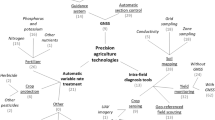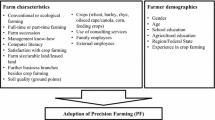Abstract
The adoption of precision farming techniques (PFTs) has been widely studied targeting specific PFT or farming systems along with the potential benefits of these PFTs in terms of yield or input use. However, few studies have examined how PFTs are adopted and used at the farm level. In this study a preliminary investigation was made of on-farm PFT uses in the Oise region (northern France). Three main PFTs were identified in the area: Global Navigation Satellite Systems (GNSS) guidance, section control, and variable rate (VR) application. For each farm, the use of every PFT was defined by the technical characteristics of the equipment, the field operation(s) concerned, the targeted crop(s), the aim of the use, the PFT adoption drivers, and the perceived impacts by the farmers. These different variables were combined into a typology of PFT uses. The results show that most of the farms combined GNSS guidance for all technical operations and section control, whereas VR application was less common. Section control was largely used by farmers for liquid fertilizers and phytochemical spraying. The typology shows three to five types of use for each PFT, which differ in terms of technique adoption drivers, e.g. reducing on-farm work or adaptation to field morphology. According to literature, economic impacts were found to be the most frequent, however farmers seemed unable to quantify them. Social impacts such as reduced work time and fatigue were also frequent and are becoming the main motivation for using PFT on farms studied. Further research is needed to assess the use trajectories of PFT along with the motivations of each PFT use.




Similar content being viewed by others
References
Agreste. (2016). L’équipement dans les exploitations agricoles. http://agreste.agriculture.gouv.fr/IMG/pdf/primeur334.pdf. Accessed 14 September 2018.
Agreste. (2017). Panorama du monde agricole, forestier, alimentaire—Série Hauts de France. http://draaf.hauts-de-france.agriculture.gouv.fr/IMG/pdf/2-exploitations-agricoles_cle08b514.pdf. Accessed 14 September 2018.
Agreste—Hauts de France. (2017). Memento de la statistique agricole. http://draaf.hauts-de-france.agriculture.gouv.fr/IMG/pdf/memento-2017_cle02595f.pdf. Accessed 14 September 2018.
Arvalis. (2015). Agriculture de Précison. Editions Arvalis. Paris (France), p. 114.
Awad, S. (2016). A review of the past, present and future of precision agriculture in the UK (Research Report No. 87). UK: AHDB Cereals & Oilseeds. https://cereals.ahdb.org.uk/media/1126475/rr87.pdf.
Balafoutis, A., Beck, B., Fountas, S., Vangeyte, J., Wal, T., Soto, I., et al. (2017). Precision agriculture technologies positively contributing to GHG emissions mitigation. Farm Productivity and Economics. Sustainability,9(8), 1339. https://doi.org/10.3390/su9081339.
Batte, M. T., & Arnholt, M. W. (2003). Precision farming adoption and use in Ohio: Case studies of six leading-edge adopters. Computers and Electronics in Agriculture,38(2), 125–139. https://doi.org/10.1016/S0168-1699(02)00143-6.
Busse, M., Doernberg, A., Siebert, R., Kuntosch, A., Schwerdtner, W., König, B., et al. (2014). Innovation mechanisms in German precision farming. Precision Agriculture,15(4), 403–426. https://doi.org/10.1007/s11119-013-9337-2.
Castle, M. H., Lubben, B. D., & Luck, J. D. (2016). Factors Influencing the Adoption of Precision Agriculture Technologies by Nebraska Producers. Presentations, Working Papers, and Gray Literature: Agricultural Economics, Paper 49.
Cavallo, E., Ferrari, E., Bollani, L., & Coccia, M. (2015). Attitudes and behaviour of adopters of technological innovations in agricultural tractors: A case study in Italian Agricultural System. Agricultural Systems,130, 44–54. https://doi.org/10.1016/j.agsy.2014.05.012.
Cockburn, A. (1997). Structuring use cases with goals. http://pdfs.semanticscholar.org/674c/ce7cfcacefaa26c67cd9735828439da0c900.pdf. Accessed 7 February 2017.
Corbetta, P. (2018). Social research: Theory, methods and techniques. London: SAGE Publications. https://doi.org/10.4135/9781849209922.
CRAAP. (2010). Présentation des systèmes d’exploitation agricole de Picardie. Chambre Régionale d’Agriculture de Picardie. http://www.hautsdefrance.chambres-agriculture.fr/fileadmin/user_upload/Hauts-de-France/029_Inst-Hauts-de-France/Exploitation-agricole/Rubrique_%C3%A9conomique/presentation_systemes_EA_dePicardie.pdf. Accessed 12 May 2017.
Daberkow, S. G., & McBride, W. D. (2003). Farm and operator characteristics affecting the awareness and adoption of precision agriculture technologies in the US. Precision Agriculture,4(2), 163–177. https://doi.org/10.1023/A:1024557205871.
DEFRA. (2013). Farm practices survey October 2012—current farming issues. England: Department for Environment Food and Rural Affairs. https://www.gov.uk/government/statistics/farm-practices-survey-october-2012-current-farming-issues.
Diacono, M., Rubino, P., & Montemurro, F. (2013). Precision nitrogen management of wheat. A review. Agronomy for Sustainable Development,33(1), 219–241. https://doi.org/10.1007/s13593-012-0111-z.
EPRS. (2016). Precision agriculture and the future of farming in Europe. Scientific Foresight Study. Brussels, European Parliament Research Service. http://www.europarl.europa.eu/RegData/etudes/STUD/2016/581892/EPRS_STU(2016)581892_EN.pdf.
European Parliament. Directive 2000/60/EC of the European Parliament and of the Council of 23 October 2000 establishing a framework for Community action in the field of water policy., OJ L 327 (2000). http://data.europa.eu/eli/dir/2000/60/oj/eng. Accessed 4 December 2018.
EUROSTAT. (2010). RAMON—Reference And Management Of Nomenclatures. NUTS (Nomenclature of Territorial Units for Statistics), by regional level, version 2010 (NUTS 2010). http://ec.europa.eu/eurostat/ramon/nomenclatures/index.cfm?TargetUrl=LST_CLS_DLD&StrNom=NUTS_33&StrLanguageCode=EN.
Fountas, S., Blackmore, S., Ess, D., Hawkins, S., Blumhoff, G., Lowenberg-Deboer, J., et al. (2005). Farmer Experience with precision agriculture in Denmark and the US Eastern Corn Belt. Precision Agriculture,6(2), 121–141. https://doi.org/10.1007/s11119-004-1030-z.
Gavaland, A., & Goutiers, V. (2013). L’agriculture de précision : applications et perspectives en grandes cultures et prairies. http://prodinra.inra.fr/record/211868. Accessed 7 February 2017.
Hallet, P., Balana, B., & Towers, W. (2012). Studies to inform policy development with regard to soil degradation: Subproject A: Cost curve for mitigation of soil compaction (No. Defra SP1305 (CTE 1024)). The James Hutton Institution. http://pdfs.semanticscholar.org/9fc0/074b264e1b4a6d63c1acd90397c0703276b0.pdf?_ga=2.161089141.93282684.1555135740-1762951547.1555135740. Accessed 13 September 2018
Invivo. (2016). Focus sur l’agriculture de précision. https://www.invivo-group.com/fr/focus-sur-lagriculture-de-precision. Accessed 7 February 2017.
Jeuffroy, M. H., Gate, P., Machet, J. M., & Recous, S. (2013). Gestion de l’azote en grandes cultures: les connaissances et outils disponibles permettent-ils de concilier exigencesagronomiques et environnementales ? Cahiers Agricultures,22(4), 249–257. https://doi.org/10.1684/agr.2013.0639.
Kernecker, M., Knierim, A., & Wurbs, A. (2016). Report on farmers’ needs, innovative ideas and interests, SmartAKIS. http://www.smart-akis.com/wp-content/uploads/2017/02/D2.2.-Report-on-farmers-needs.pdf. Accessed 17 October 2017
Landais, E. (1998). Modelling farm diversity: new approaches to typology building in France. Agricultural Systems,58(4), 505–527. https://doi.org/10.1016/S0308-521X(98)00065-1.
Larson, J. A., Velandia, M. M., Buschermohle, M. J., & Westlund, S. M. (2016). Effect of field geometry on profitability of automatic section control for chemical application equipment. Precision Agriculture,17(1), 18–35. https://doi.org/10.1007/s11119-015-9404-y.
Lepej, P., & Rakun, J. (2016). Simultaneous localisation and mapping in a complex field environment. Biosystems Engineering,150, 160–169. https://doi.org/10.1016/j.biosystemseng.2016.08.004.
Levavasseur, F., Martin, P., Bouty, C., Barbottin, A., Bretagnolle, V., Thérond, O., et al. (2016). RPG Explorer: A new tool to ease the analysis of agricultural landscape dynamics with the Land Parcel Identification System. Computers and Electronics in Agriculture,127, 541–552. https://doi.org/10.1016/j.compag.2016.07.015.
Llewellyn, R., & Ouzman, J. (2014). Adoption of Precision Agriculture-related Practices: Status, Opportunities and the Role of Farm Advisors. Montpellier, France: CSIRO. https://grdc.com.au/resources-and-publications/all-publications/publications/2014/12/adoption-of-precision-agriculture-related-practices. Accessed 12 September 2018.
Lowder, S. K., Skoet, J., & Raney, T. (2016). The number, size, and distribution of farms, smallholder farms, and family farms worldwide. World Development,87, 16–29. https://doi.org/10.1016/j.worlddev.2015.10.041.
Luck, J. D., Pitla, S. K., Shearer, S. A., Mueller, T. G., Dillon, C. R., Fulton, J. P., et al. (2010). Potential for pesticide and nutrient savings via map-based automatic boom section control of spray nozzles. Computers and Electronics in Agriculture,70(1), 19–26. https://doi.org/10.1016/j.compag.2009.08.003.
Melchiori, R. J. M., Albarenque, S. M., & Kemerer, A. C. (2013). Uso, adopción y limitaciones de la agricultura de precisión en Argentina. Presented at the Curso Int. Agricultura de Precision, Manfredi, Córdoba, Argentina. https://inta.gob.ar/sites/default/files/script-tmp-inta_uso_adopcin_y_limitaciones_de_la_agricultura_de_.pdf.
Molin, J. (2016). Precision agriculture in Latin America. Presented at the INFO AG Conference, St. Louis, MO, USA. https://www.infoag.org/presentations/2378.pdf. Accessed 13 September 2018.
Paustian, M., & Theuvsen, L. (2017). Adoption of precision agriculture technologies by German crop farmers. Precision Agriculture,18(5), 701–716. https://doi.org/10.1007/s11119-016-9482-5.
Pedersen, S. M., Fountas, S., Blackmore, B. S., Gylling, M., & Pedersen, J. L. (2004). Adoption and perspectives of precision farming in Denmark. Acta Agriculturae Scandinavica Section B: Soil & Plant Science,54(1), 2–8. https://doi.org/10.1080/09064710310019757.
Pierpaoli, E., Carli, G., Pignatti, E., & Canavari, M. (2013). Drivers of Precision Agriculture Technologies Adoption: A Literature Review. 6th International Conference on Information and Communication Technologies in Agriculture, Food and Environment (HAICTA 2013), 8, 61–69. https://doi.org/10.1016/j.protcy.2013.11.010.
Polling, B., Herold, L., & Volgman, A. (2010). Typology of farms and regions in EU states assessing the impacts of Precision Farming-Technologies in EU-farms, FutureFarm Project, p. 53.
Reichardt, M., & Jürgens, C. (2009). Adoption and future perspective of precision farming in Germany: Results of several surveys among different agricultural target groups. Precision Agriculture,10(1), 73–94. https://doi.org/10.1007/s11119-008-9101-1.
Say, S. M., Keskin, M., Sehri, M., & Sekermi, Y. E. (2017). Adoption of precision agriculture technologies in developed and developing countries (pp. 41–49). Presented at the International Science and Technology Conference (ISTEC), Berlin, Germany.
Schimmelpfennig, D. (2016). Farm Profits and the Adoption of Precision Agriculture (Economic Research Report No. 217). USDA Economic Research Service.
Swinton, S. M., & Lowenberg-DeBoer, J. (1998). Evaluating the profitability of site-specific farming. Journal of Production Agriculture,11(4), 439–446. https://doi.org/10.2134/jpa1998.0439.
Velandia, M., Buschermohle, M., Larson, J. A., Thompson, N. M., & Jernigan, B. M. (2013). The economics of automatic section control technology for planters: A case study of middle and west Tennessee farms. Computers and Electronics in Agriculture,95, 1–10. https://doi.org/10.1016/j.compag.2013.03.006.
Zarco-Tejada, P. J., Hubbard, N., & Loudjani, P. (2014). Precision agriculture: An opportunity for EU farmers—potential support with the CAP 2014-2020. Joint Research Centre (JRC) of the European Commission. https://doi.org/10.2861/58758.
Acknowledgements
We warmly acknowledge the group of students in agricultural engineering “Agronomie et Territoire” at UniLaSalle for their hard work in the initial phases of the research: Hélène Callewaert, Jean Manuel Clabaut, Juliette Descotes, Lucie Deterpigny, Marie Thérèse Gässler, Estelle Harant, Pierre Lauwerier, François Mathellié, Axel Moilleron, Damien Prévost (†) and Hélène Vanbesalaere, as well as useful discussions with Sophie Wieruszeski and Florian Vigneron from the Oise agricultural Chamber. 23 farmers answered our questions, and many thanks to all of them. We acknowledge the editor for helpful and constructive comments. This research did not receive any specific grant from funding agencies in the public, commercial, or not-for-profit sectors.
Author information
Authors and Affiliations
Corresponding author
Ethics declarations
Conflicts of interest
The authors declare no conflict of interest.
Additional information
Publisher's Note
Springer Nature remains neutral with regard to jurisdictional claims in published maps and institutional affiliations.
Rights and permissions
About this article
Cite this article
Ayerdi Gotor, A., Marraccini, E., Leclercq, C. et al. Precision farming uses typology in arable crop-oriented farms in northern France. Precision Agric 21, 131–146 (2020). https://doi.org/10.1007/s11119-019-09660-y
Published:
Issue Date:
DOI: https://doi.org/10.1007/s11119-019-09660-y




